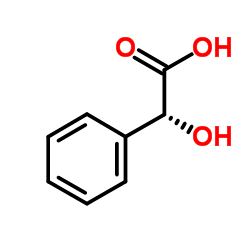(S)-(+)-Mandelic acid

(S)-(+)-Mandelic acid structure
|
Common Name | (S)-(+)-Mandelic acid | ||
|---|---|---|---|---|
| CAS Number | 17199-29-0 | Molecular Weight | 152.15 | |
| Density | 1.3±0.1 g/cm3 | Boiling Point | 321.8±22.0 °C at 760 mmHg | |
| Molecular Formula | C8H8O3 | Melting Point | 131-134 °C(lit.) | |
| MSDS | Chinese USA | Flash Point | 162.6±18.8 °C | |
|
Simultaneous determination of aromatic acid metabolites of styrene and styrene-oxide in rat urine by gas chromatography-flame ionization detection.
J. Anal. Toxicol. 36(5) , 312-8, (2012) A convenient and reliable gas chromatographic method was developed for the simultaneous determination of six aromatic acid metabolites of styrene and styrene-oxide in rat urine; i.e., benzoic (BA), phenylacetic (PAA), mandelic (MA), phenylglyoxylic (PGA), hip... |
|
|
Chiral separation of D,L-mandelic acid through cellulose membranes.
Chirality 23(5) , 379-82, (2011) This work reports the chiral separation of D,L-mandelic acid with cellulose membranes. Cellulose was chosen as membrane material because it possesses multichiral carbon atoms in its molecular structure unit. The flux and permselective properties of membrane u... |
|
|
DNA damage and susceptibility assessment in industrial workers exposed to styrene.
J. Toxicol. Environ. Health A 75(13-15) , 735-46, (2012) Styrene is a widely used chemical in the manufacture of synthetic rubber, resins, polyesters, and plastics. The highest levels of human exposure to styrene occur during the production of reinforced plastic products. The objective of this study was to examine ... |
|
|
A chiral bisthiourea as a chiral solvating agent for carboxylic acids in the presence of DMAP.
J. Org. Chem. 78(18) , 9137-42, (2013) A simple chiral bisthiourea has been used as a highly effective and practical chemical solvating agent (CSA) for diverse α-carboxylic acids in the presence of DMAP. Excellent enantiodiscrimination based on well-resolved α-H NMR signals of the enantiomers of c... |
|
|
Successful short-term and long-term treatment of melasma and postinflammatory hyperpigmentation using vitamin C with a full-face iontophoresis mask and a mandelic/malic acid skin care regimen.
Journal. of. Drugs in. Dermatology. 12(1) , 45-50, (2013) Treatment of melasma and postinflammatory hyperpigmentation is often challenging. No ideal short-term and long-term treatment is available. Vitamin C alone and in combination with iontophoresis has been studied and found to be useful; however, no long-term st... |
|
|
Study on the metabolic mechanism of chiral inversion of S-mandelic acid in vitro.
Chirality 24(1) , 86-95, (2012) Mandelic acid (MA) is generally used as a biological indicator of occupational exposure to styrene, which is classified as a class of hazardous environmental pollutants. It was found to undergo one-directional chiral inversion (S-MA to R-MA) in Wistar and Spr... |
|
|
Preparation of molecularly imprinted resin based on chitosan for chiral recognition of S-mandelic acid.
Int. J. Biol. Macromol. 55 , 207-13, (2013) An enantioselective S-mandelic acid (S-MA) imprinted chitosan (SMIC) was prepared by cross-linking of chitosan using formaldehyde cross-linker, in the presence of S-MA as an imprint template molecule and 0.5% acetic acid solution as a solvent. Non-imprinted c... |
|
|
Expression and characterization of a novel enantioselective lipase from Aspergillus fumigatus.
Appl. Biochem. Biotechnol. 168(7) , 1820-33, (2012) A 1,080-bp cDNA (CGMCC 2873) encoding of a cold-active lipase of Aspergillus fumigatus (AFL67) was cloned and expressed in Escherichia coli for the first time. The new lipase, AFL67, was one-step purified by 8.30 folds through Ni-NTA affinity chromatography w... |
|
|
Self-assembly of L-cysteine for chiral recognition of mandelic acid in gas phase.
J. Nanosci. Nanotechnol. 12(12) , 8874-8, (2012) This study demonstrates a new approach for the selective recognition of chiral mandelic acid by quartz crystal microbalance (QCM) using L-cysteine as the selector. The modification of L-cysteine on the QCM sensor was identified using resonant frequency detect... |
|
|
Occupational exposure to styrene in the fibreglass reinforced plastic industry: comparison between two different manufacturing processes.
Med. Lav. 103(5) , 402-12, (2012) Styrene is used in manufacturing fiberglass reinforced plastics: and occupational exposure was related to neurotoxicology and genotoxicity. The sum of the metabolites mandelic and phenylglyoxylic acids is the ACGIH biomarker for occupational exposure with a B... |